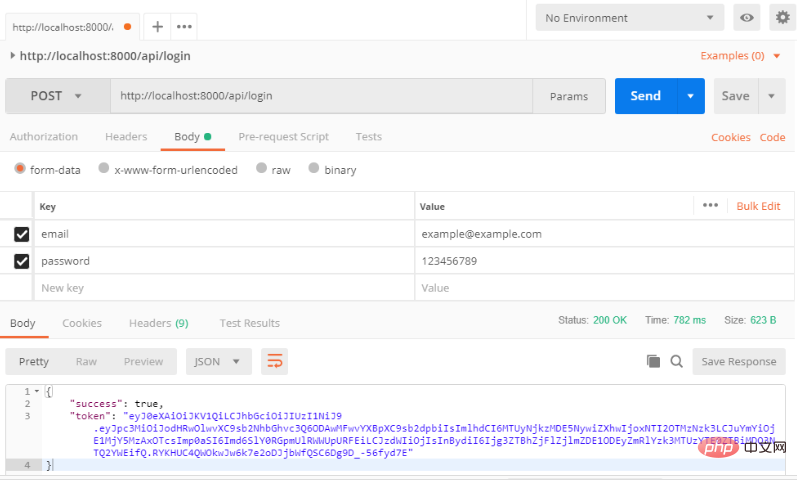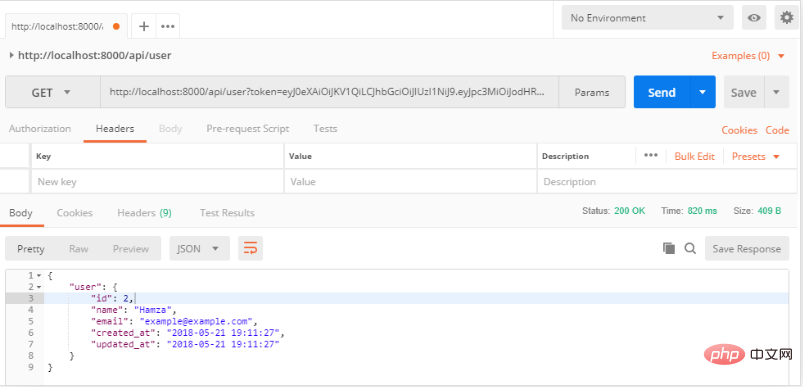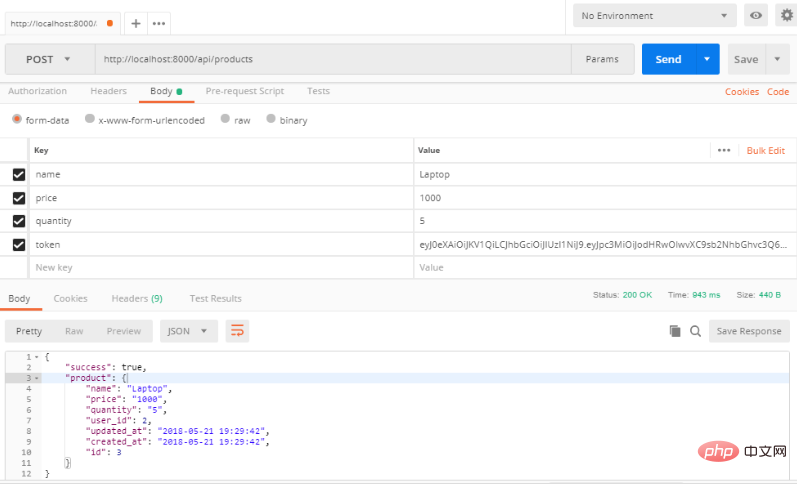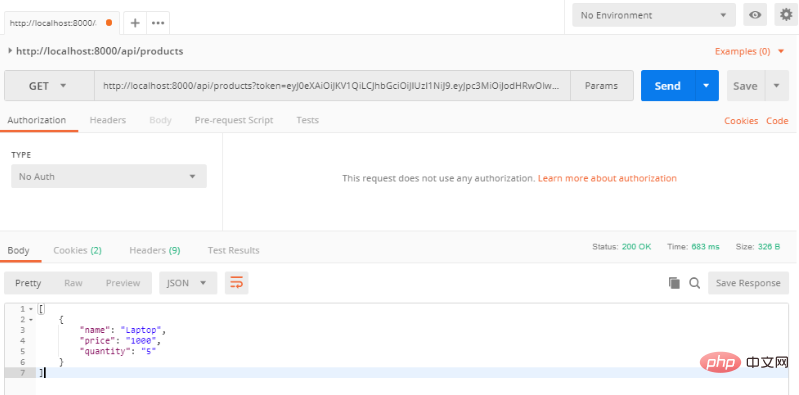使用Laravel整合JWT認證開發RestfulApi
- Guanhui轉載
- 2020-05-09 10:43:452596瀏覽
在這篇文章中,我們將學習如何使用 JWT 驗證在 Laravel 中建立 restful API 。 JWT 代表 JSON Web Tokens 。我們還將使用 API 為用戶產品建立功能齊全的 CRUD 應用。
在使用跨平台應用程式時, API 是一個非常不錯的選擇。除了網站,您的產品可能還有 Android 和 iOS 應用程式。在這種情況下, API 也是同樣出色的,因為您可以在不更改任何後端程式碼的情況下編寫不同的前端。使用 API 時,只需使用一些參數點擊 GET , POST 或其他類型的請求,伺服器就會返回 JSON (JavaScript Object Notation) 格式的一些數據,這些數據由客戶端應用程式處理。
說明
我們先寫下我們的應用程式詳細資訊和功能。我們將使用 JWT 驗證在 laravel 中使用 restful API 建立基本使用者產品清單。
A User 將會使用以下功能
註冊並建立一個新帳戶
登錄到他們的帳戶
註銷和丟棄token 並離開應用程式
以取得登入使用者的詳細資訊
- ##檢索可供使用者使用的產品清單
- 按ID 尋找特定產品
- 將新產品新增至使用者產品清單中
- 編輯現有產品詳細資料
- 從使用者清單中刪除現有產品
User 必填
- name
- password
Product 必填
- name
- price
- quantity
#建立新的專案
透過執行下面的命令,我們就可以開始並建立新的Laravel 專案。 composer create-project --prefer-dist laravel/laravel jwt這會在名為 jwt 的目錄下建立一個新的 Laravel 專案。設定 JWT 擴充包
我們會使用 tymondesigns/jwt-auth 擴充包來讓我們在 Laravel 中使用 JWT。安裝 tymon/jwt-auth 擴充包
讓我們在這個 Laravel 應用程式中安裝這個擴充包。如果您正在使用Laravel 5.5 或以上版本,請執行以下指令來取得dev-develop 版本的JWT 套件:composer require tymon/jwt-auth:dev-develop --prefer-source如果您正在使用Laravel 5.4 或以下版本,那麼請執行下面這條指令:
composer require tymon/jwt-auth對於Laravel 版本低於5.5 的應用,您也要在config/app.php 檔案中設定服務提供者和別名。
'providers' => [
....
Tymon\JWTAuth\Providers\JWTAuthServiceProvider::class,
....
],
'aliases' => [
....
'JWTAuth' => Tymon\JWTAuth\Facades\JWTAuth::class,
'JWTFactory' => 'Tymon\JWTAuth\Facades\JWTFactory',
....
],如果您的 Laravel 版本為 5.5 或以上,Laravel 會進行「套件自動發現」。
發布設定檔
對於5.5 或以上版本的Laravel,請使用下方這條指令來發佈設定檔:php artisan vendor:publish --provider="Tymon\JWTAuth\Providers\LaravelServiceProvider"對於先前先前版本的Laravel,那麼應該執行下面這條指令:
php artisan vendor:publish --provider="Tymon\JWTAuth\Providers\JWTAuthServiceProvider"上面的指令會產生config/jwt.php 設定檔。除去註解部分,設定檔會像這樣:
<?php
return [
'secret' => env('JWT_SECRET'),
'keys' => [
'public' => env('JWT_PUBLIC_KEY'),
'private' => env('JWT_PRIVATE_KEY'),
'passphrase' => env('JWT_PASSPHRASE'),
],
'ttl' => env('JWT_TTL', 60),
'refresh_ttl' => env('JWT_REFRESH_TTL', 20160),
'algo' => env('JWT_ALGO', 'HS256'),
'required_claims' => [
'iss',
'iat',
'exp',
'nbf',
'sub',
'jti',
],
'persistent_claims' => [
// 'foo',
// 'bar',
],
'lock_subject' => true,
'leeway' => env('JWT_LEEWAY', 0),
'blacklist_enabled' => env('JWT_BLACKLIST_ENABLED', true),
'blacklist_grace_period' => env('JWT_BLACKLIST_GRACE_PERIOD', 0),
'decrypt_cookies' => false,
'providers' => [
'jwt' => Tymon\JWTAuth\Providers\JWT\Lcobucci::class,
'auth' => Tymon\JWTAuth\Providers\Auth\Illuminate::class,
'storage' => Tymon\JWTAuth\Providers\Storage\Illuminate::class,
],
];
產生JWT 金鑰##JWT 令牌透過一個加密的金鑰來簽發。對於 Laravel 5.5 或以上版本,執行下面的命令來產生密鑰以便用於簽發令牌。
php artisan jwt:secret
Laravel 版本低於 5.5 的則運行:
php artisan jwt:generate
這篇教學使用 Laravel 5.6。教程中接下來的步驟只在 5.5 和 5.6 測試過。可能不適用於 Laravel 5.4 或以下版本。您可以閱讀 針對舊版 Laravel 的文件。
註冊中間件JWT 認證擴充包附帶了允許我們使用的中間件。在 app/Http/Kernel.php 中註冊 auth.jwt 中間件:
protected $routeMiddleware = [
....
'auth.jwt' => \Tymon\JWTAuth\Http\Middleware\Authenticate::class,
];這個中間件會透過檢查請求中附帶的令牌來校驗使用者的認證。如果使用者未認證,這個中間件會拋出 UnauthorizedHttpException 例外。
設定路由開始之前,我們將為所有本教學討論的點設定路由。打開 routes/api.php 並將下面的路由複製到您的檔案中。
Route::post('login', 'ApiController@login');
Route::post('register', 'ApiController@register');
Route::group(['middleware' => 'auth.jwt'], function () {
Route::get('logout', 'ApiController@logout');
Route::get('user', 'ApiController@getAuthUser');
Route::get('products', 'ProductController@index');
Route::get('products/{id}', 'ProductController@show');
Route::post('products', 'ProductController@store');
Route::put('products/{id}', 'ProductController@update');
Route::delete('products/{id}', 'ProductController@destroy');
});
更新 User 模型#JWT 需要在 User 模型中實作 Tymon\JWTAuth\Contracts\JWTSubject 介面。此介面需要實作兩個方法 getJWTIdentifier 和 getJWTCustomClaims。使用以下內容更新 app/User.php 。
<?php
namespace App;
use Illuminate\Foundation\Auth\User as Authenticatable;
use Illuminate\Notifications\Notifiable;
use Tymon\JWTAuth\Contracts\JWTSubject;
class User extends Authenticatable implements JWTSubject
{
use Notifiable;
/**
* The attributes that are mass assignable.
*
* @var array
*/
protected $fillable = [
'name', 'email', 'password',
];
/**
* The attributes that should be hidden for arrays.
*
* @var array
*/
protected $hidden = [
'password', 'remember_token',
];
/**
* Get the identifier that will be stored in the subject claim of the JWT.
*
* @return mixed
*/
public function getJWTIdentifier()
{
return $this->getKey();
}
/**
* Return a key value array, containing any custom claims to be added to the JWT.
*
* @return array
*/
public function getJWTCustomClaims()
{
return [];
}
}
JWT 驗證邏輯#讓我們使用 JWT 驗證在 laravel 中寫 Restful API 的邏輯。
用户注册时需要姓名,邮箱和密码。那么,让我们创建一个表单请求来验证数据。通过运行以下命令创建名为 RegisterAuthRequest 的表单请求:
php artisan make:request RegisterAuthRequest
它将在 app/Http/Requests 目录下创建 RegisterAuthRequest.php 文件。将下面的代码黏贴至该文件中。
<?php
namespace App\Http\Requests;
use Illuminate\Foundation\Http\FormRequest;
class RegisterAuthRequest extends FormRequest
{
/**
* 确定是否授权用户发出此请求
*
* @return bool
*/
public function authorize()
{
return true;
}
/**
* 获取应用于请求的验证规则
*
* @return array
*/
public function rules()
{
return [
'name' => 'required|string',
'email' => 'required|email|unique:users',
'password' => 'required|string|min:6|max:10'
];
}
}运行以下命令创建一个新的 ApiController :
php artisan make:controller ApiController
这将会在 app/Http/Controllers 目录下创建 ApiController.php 文件。将下面的代码黏贴至该文件中。
<?php
namespace App\Http\Controllers;
use App\Http\Requests\RegisterAuthRequest;
use App\User;
use Illuminate\Http\Request;
use JWTAuth;
use Tymon\JWTAuth\Exceptions\JWTException;
class ApiController extends Controller
{
public $loginAfterSignUp = true;
public function register(RegisterAuthRequest $request)
{
$user = new User();
$user->name = $request->name;
$user->email = $request->email;
$user->password = bcrypt($request->password);
$user->save();
if ($this->loginAfterSignUp) {
return $this->login($request);
}
return response()->json([
'success' => true,
'data' => $user
], 200);
}
public function login(Request $request)
{
$input = $request->only('email', 'password');
$jwt_token = null;
if (!$jwt_token = JWTAuth::attempt($input)) {
return response()->json([
'success' => false,
'message' => 'Invalid Email or Password',
], 401);
}
return response()->json([
'success' => true,
'token' => $jwt_token,
]);
}
public function logout(Request $request)
{
$this->validate($request, [
'token' => 'required'
]);
try {
JWTAuth::invalidate($request->token);
return response()->json([
'success' => true,
'message' => 'User logged out successfully'
]);
} catch (JWTException $exception) {
return response()->json([
'success' => false,
'message' => 'Sorry, the user cannot be logged out'
], 500);
}
}
public function getAuthUser(Request $request)
{
$this->validate($request, [
'token' => 'required'
]);
$user = JWTAuth::authenticate($request->token);
return response()->json(['user' => $user]);
}
}让我解释下上面的代码发生了什么。
在 register 方法中,我们接收了 RegisterAuthRequest 。使用请求中的数据创建用户。如果 loginAfterSignUp 属性为 true ,则注册后通过调用 login 方法为用户登录。否则,成功的响应则将伴随用户数据一起返回。
在 login 方法中,我们得到了请求的子集,其中只包含电子邮件和密码。以输入的值作为参数调用 JWTAuth::attempt() ,响应保存在一个变量中。如果从 attempt 方法中返回 false ,则返回一个失败响应。否则,将返回一个成功的响应。
在 logout 方法中,验证请求是否包含令牌验证。通过调用 invalidate 方法使令牌无效,并返回一个成功的响应。如果捕获到 JWTException 异常,则返回一个失败的响应。
在 getAuthUser 方法中,验证请求是否包含令牌字段。然后调用 authenticate 方法,该方法返回经过身份验证的用户。最后,返回带有用户的响应。
身份验证部分现在已经完成。
构建产品部分
要创建产品部分,我们需要 Product 模型,控制器和迁移文件。运行以下命令来创建 Product 模型,控制器和迁移文件。
php artisan make:model Product -mc
它会在 database/migrations 目录下创建一个新的数据库迁移文件 create_products_table.php,更改 up 方法。
public function up()
{
Schema::create('products', function (Blueprint $table) {
$table->increments('id');
$table->integer('user_id');
$table->string('name');
$table->integer('price');
$table->integer('quantity');
$table->timestamps();
$table->foreign('user_id')
->references('id')
->on('users')
->onDelete('cascade');
});
}向 Product 模型中添加 fillable 属性。在 app 目录下打开 Product.php 文件并添加属性。
protected $fillable = [
'name', 'price', 'quantity'
];现在在 .env 文件中设置数据库凭证,并通过运行以下命令迁移数据库。
php artisan migrate
现在,我们必须在 User 模型中添加一个关系来检索相关产品。在 app/User.php 中添加以下方法。
public function products()
{
return $this->hasMany(Product::class);
}在 app/Http/Controllers 目录下打开 ProductController.php 文件。在文件开头添加 use 指令覆盖上一个。
use App\Product; use Illuminate\Http\Request; use JWTAuth;
现在我们将实现五个方法。
index, 为经过身份认证的用户获取所有产品列表
show, 根据 ID 获取特定的产品
store, 将新产品存储到产品列表中
update, 根据 ID 更新产品详情
destroy, 根据 ID 从列表中删除产品
添加一个构造函数来获取经过身份认证的用户,并将其保存在 user 属性中。
protected $user;
public function __construct()
{
$this->user = JWTAuth::parseToken()->authenticate();
}parseToken 将解析来自请求的令牌, authenticate 通过令牌对用户进行身份验证。
让我们添加 index 方法。
public function index()
{
return $this->user
->products()
->get(['name', 'price', 'quantity'])
->toArray();
}上面的代码非常简单,我们只是使用 Eloquent 的方法获取所有的产品,然后将结果组成一个数组。最后,我们返回这个数组。Laravel 将自动将其转换为 JSON ,并创建一个为 200 成功的响应码。
继续实现 show 方法。
public function show($id)
{
$product = $this->user->products()->find($id);
if (!$product) {
return response()->json([
'success' => false,
'message' => 'Sorry, product with id ' . $id . ' cannot be found'
], 400);
}
return $product;
}这个也非常容易理解。我们只需要根据 ID 找到该产品。如果产品不存在,则返回 400 故障响应。否则,将返回产品数组。
接下来是 store 方法
public function store(Request $request)
{
$this->validate($request, [
'name' => 'required',
'price' => 'required|integer',
'quantity' => 'required|integer'
]);
$product = new Product();
$product->name = $request->name;
$product->price = $request->price;
$product->quantity = $request->quantity;
if ($this->user->products()->save($product))
return response()->json([
'success' => true,
'product' => $product
]);
else
return response()->json([
'success' => false,
'message' => 'Sorry, product could not be added'
], 500);
}在 store 方法中,验证请求中是否包含名称,价格和数量。然后,使用请求中的数据去创建一个新的产品模型。如果,产品成功的写入数据库,会返回成功响应,否则返回自定义的 500 失败响应。
实现 update 方法
public function update(Request $request, $id)
{
$product = $this->user->products()->find($id);
if (!$product) {
return response()->json([
'success' => false,
'message' => 'Sorry, product with id ' . $id . ' cannot be found'
], 400);
}
$updated = $product->fill($request->all())
->save();
if ($updated) {
return response()->json([
'success' => true
]);
} else {
return response()->json([
'success' => false,
'message' => 'Sorry, product could not be updated'
], 500);
}
}在 update 方法中,我们通过 id 取得产品。如果产品不存在,返回一个 400 响应。然后,我们把请求中的数据使用 fill 方法填充到产品详情。更新产品模型并保存到数据库,如果记录成功更新,返回一个 200 成功响应,否则返回 500 内部服务器错误响应给客户端。
现在,让我们实现 destroy 方法。
public function destroy($id)
{
$product = $this->user->products()->find($id);
if (!$product) {
return response()->json([
'success' => false,
'message' => 'Sorry, product with id ' . $id . ' cannot be found'
], 400);
}
if ($product->delete()) {
return response()->json([
'success' => true
]);
} else {
return response()->json([
'success' => false,
'message' => 'Product could not be deleted'
], 500);
}
}在 destroy 方法中,我们根据 ID 获取产品,如果产品不存在,则返回 400 响应。然后我们删除产品后并根据删除操作的成功状态返回适当的响应。
控制器代码现在已经完成,完整的控制器代码在这。
测试
我们首先来测试身份认证。我们将使用 serve 命令在开发机上启动 Web 服务,你也可以使用虚拟主机代替。运行以下命令启动 Web 服务。
php artisan serve
它将监听 localhost:8000
为了测试 restful API's,我们使用 Postman。填写好请求体之后,我们请求一下 register 路由。

發送請求,你將獲得令牌。

我們的用戶現在已註冊並通過身份驗證。我們可以發送另一個請求來偵測 login 路由,結果會傳回 200 和令牌。

取得使用者詳情

#測試認證已完成。接下來測試產品部分,先建立一個產品。

現在,透過請求 index 方法取得產品。

你可以測試其它路由,它們都會正常運作。
推薦教學:《Laravel教學》
以上是使用Laravel整合JWT認證開發RestfulApi的詳細內容。更多資訊請關注PHP中文網其他相關文章!

